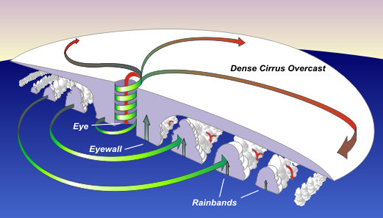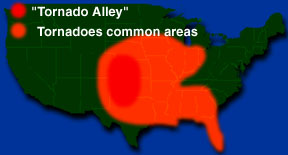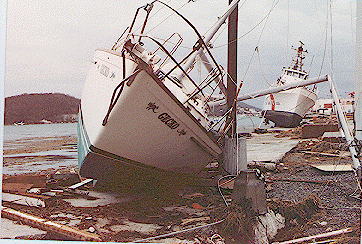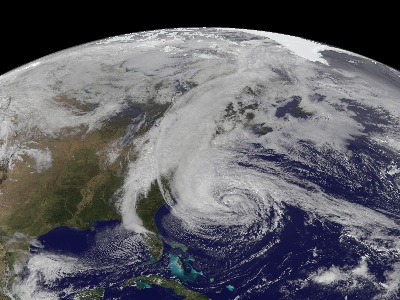An image of Hurricane Sandy taken by the GOES-13 satellite on October 28. This category 1
hurricane was huge, spanning a horizontal distance of about one-third the US continental landmass. The storm came onshore in New Jersey, and gradually moved northeast. The storm disrupted the lives of tens of millions in the eastern US, doing billions of dollars in damage, resulting in over 30 deaths. Visit the National Hurricane Center's webpage on
Hurricane Sandy for details.
Click on image for full size
Image courtesy of NASA
Hurricanes (also known as Tropical Cyclones)
As a strong hurricane heads towards the coast, people prepare - boarding up houses, packing the car, and evacuating. These storms can spell disaster for people in hurricane prone areas, so they are taken very seriously. They are the most powerful of all weather systems and they are huge - an average of 340 miles across.
Hurricanes form in the tropics over warm ocean water and die down when they move over land or out of the tropics. These storms are called hurricanes in the Atlantic and typhoons or tropical cyclones in other areas of the world. In the Northern Hemisphere the storms rotate counterclockwise and in the Southern Hemisphere they rotate clockwise because of the Coriolis Effect. At the center of the rotating storm is a small area of calm weather and clear skies called the eye.
Hurricane damage in coastal areas is often due to storm surge, which floods coastal areas. Strong waves and wind also batter coastal areas. Hurricanes also cause a tremendous amount of rain. Not all storms are the same. Large and strong storms cause much more damage than small storms. In the Atlantic and Eastern Pacific, the Saffir-Simpson Hurricane Scale is used to describe the size of a hurricane.
As hurricanes move, scientists try to forecast where and when the storm will reach land in order to warn people. Hurricanes are tracked over large distances with weather satellites. Computer models that take into account factors of the storm and the atmosphere are used to predict where the storm will go. Since 1953 each hurricane has been given a name to help warn people that a storm was on its way.
Hurricanes usually happen at a particular time of year called hurricane season. The timing of hurricane season is different in different regions of the world. In the North Atlantic, hurricane season is from June 1st to November 30th each year.
You might also be interested in:

At the center of a fierce tropical storm, there is a small area where the weather is calm, the sky is clear, and the winds are just light breezes. This area is called the eye of the storm. As a hurricane
...more
Wind is moving air. Warm air rises, and cool air comes in to take its place. This movement creates different pressures in the atmosphere which creates the winds around the globe. Since the Earth spins,
...more
How many hurricanes will form this year? How strong will they be? While no one can say for sure, teams of scientists make predictions each year about the strength of the upcoming hurricane season. To make
...more
The Atlantic hurricane season was active this year. There were 10 hurricanes out of 14 named storms. (There are normally 6 hurricanes out of 10 named storms.) Scientists from different branches of the
...more
The land in the central United States is the best breeding ground for the storms which produce tornadoes. The land in the Great Plains is relatively flat, which allows cold dry polar air from Canada to
...more
Below is a list of some weather conditions that call for an advisory, watch, or warning. Severe Thunderstorm Watch: A severe thunderstorm watch is issued when a thunderstorm with winds greater than 57
...more
From the National Weather Service, Miami, Florida, 3 p.m. EDT: Bonnie battering coastal North Carlina...Flood threat from rain increasing...Hurricane warnings remain in effect from Cape Romain, South Carolina
...more















